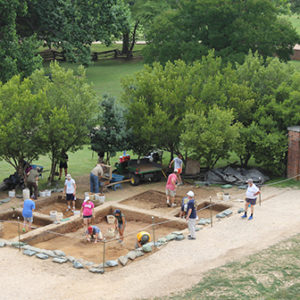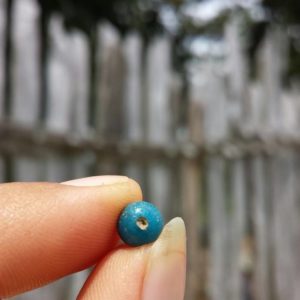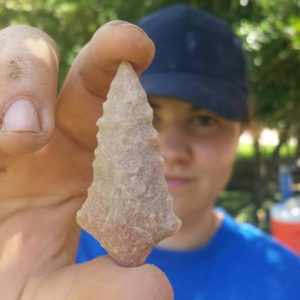For years the outstretched arms of Pocahontas have beckoned visitors to explore. Now it looks like she was also trying to call the attention of archaeologists to a major part of the James Fort extension.
Daily discoveries in the ground around her statue have led the Jamestown Rediscovery team and their 10 Field School students to open new units so they can piece together evidence from the 2011 and 2013 excavations.
In 2011 archaeologists followed the markings of a palisade wall jutting east off of the original James Fort’s eastern wall. Thought to be part of an extension that turned the original three-sided fort into one with five sides, a total of 69 feet of the wall was uncovered between excavations in 2003 and 2011.
Now the archaeologists may have found the terminus of that wall: 15 feet to the east of where they last dug that eastern palisade in 2011 sits a large posthole. That posthole—and other evidence that could indicate a cellar— may reveal a building at the corner of the five-sided version of the fort. Extending south of this corner is evidence of a palisade the team found last year running through the existing cemetery outside the 1907 Memorial Church.
This may be another chapter in the revelation that James Fort was a large undertaking with many structures and many people moving through it for decades. Twenty years of excavations by the Jamestown Rediscovery Project have not only reshaped the view of the story of the English community there but have also uncovered thousands of Native artifacts, and those continue to appear in the five units now open around the Pocahontas statue.
One of the signs of a cellar near the statue is a band of early artifacts that surround a collection of brick rubble. The rubble could be from the 1639 brick church, placed in an existing depression in the ground when workers cleared the church site to build the 1907 Memorial Church, said Dr. William M. Kelso, director of archaeological research and interpretation at Historic Jamestowne.
Last year’s evidence of a building at the corner of the fort extension included postholes that were almost six feet deep. At the time Kelso had said, “To call them postholes is almost underreporting. They are huge structural features. The only other place we found such deep postholes was at the site of the 1608 church.”
The evidence of a building is near the gate entrance to Preservation Virginia’s land on Jamestown Island. But the holes may also be part of a wall that colony secretary William Strachey described as being planks and posts—a different style of construction than the palisade of the 1607 James Fort. The plank and post style is called a paling, and that kind of construction would lead to questions about how permanent the extension of the fort was meant to be, Kelso said.
This evidence is also making the Jamestown Rediscovery staff look north of the Pocahontas statue, across an open field and into the tar swamp. Their question: during the “starving time” winter of 1609-10, was there a palisade that extended from the corner where they are now digging through the swamp and then ending at a blockhouse where the island connected to an isthmus to the mainland? It’s hard to imagine a paling going through the swamp, but Kelso said the swamp may not have been as large in the early 1600s as it is today.
“We are getting a better handle on the landscape. There is high ground through the swamp,” he said. “There was a dam behind the Ambler House; a photo from the 1930s shows it. But that’s gone now, and that’s why all the water is coming into the swamp to enlarge it and is flooding our field.”
Complicating this search is the fact this area was mined heavily for earth to make Fort Pocahontas in the Civil War and was disturbed by farming and its use as a dirt road.
The Field School students have enjoyed the flurry of activity as the veteran archaeologists pick out the new evidence and trace it.
“Sometimes it takes a day or more of troweling for me to see what they see, but I’m beginning to pick it up,” said student Ben Coats from the University of Kansas. “We were working in the first two sections, and then they quickly opened two more to the north of them. It’s really impressive to me how much we can do on the fly.”
Virginia Tech student Kaitlyn Fitzgerald agreed. “I was really surprised at how instantly hands on they were. On day two they were: ‘Alright, get in the hole!'” she said. “The more days that go by, the more sense this all makes to me.”
related images
- Photo taken from the 17th-century church tower of the 2014 Field School excavations near the Pocahontas statue
- Blue glass bead found by a Field School student
- Field School student Kelsey Timmons with Morrow Mountain projectile point
- View of open units between the Preservation Virginia entrance gate and the Pocahontas statue









